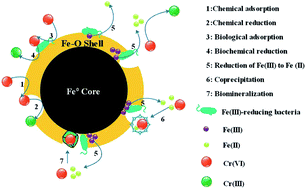Enhanced removal of chromium(vi) by Fe(iii)-reducing bacterium coated ZVI for wastewater treatment: batch and column experiments†
Abstract
In order to effectively destroy the structure of the passive oxidation film that covers zero-valent iron (ZVI), an Fe(III)-reducing strain, namely Morganella sp., was isolated from anaerobic activated sludge and coated on ZVI, which was distributed in porous ceramsite made of iron dust, kaolin and straw, with a ratio of 7 : 3 : 1. Batch experiments showed that under the optimized conditions, the maximum removal amount of Cr(VI) by ZVI increased from 7.33 mg g−1 to 26.87 mg g−1 in the presence of the Fe(III)-reducing bacterium. The column experiment was performed with the addition of the agar globules to supply nutrients to the strain. Compared with ZVI, the column penetration time and maximum capture amount of RB-ZVI increased to 17 h and 112.5 mg g−1, respectively, on the 15th day. Furthermore, the service life of RB-ZVI was prolonged in the existence of the strain. Based on X-ray diffraction, Raman spectroscopy and X-ray photoelectron spectroscopy analyses, the key mechanisms for the removal of Cr(VI) by ZVI coated with Fe(III)-reducing bacterium were determined to be adsorption, reduction, coprecipitation and biomineralization.



 Please wait while we load your content...
Please wait while we load your content...